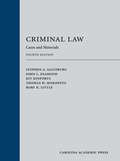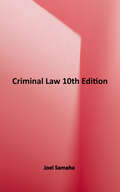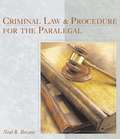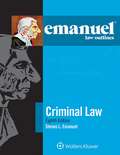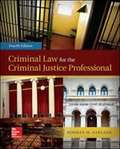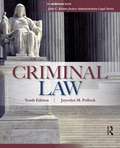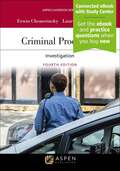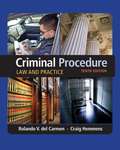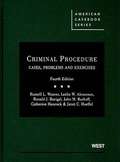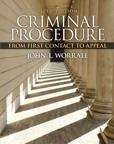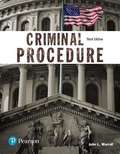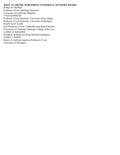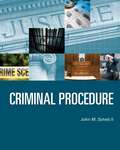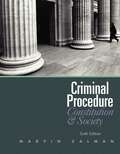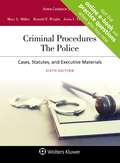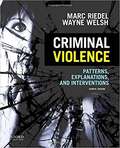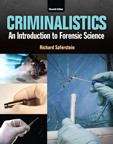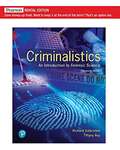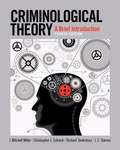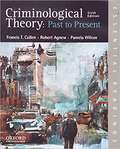- Table View
- List View
Criminal Law: Cases, Materials, and Lawyering Strategies
by David Crump Neil P. Cohen John T. Parry Penelope PetherThis casebook contains all of the subjects that ought to be covered in a first course in Criminal Law. The elements of crimes, actus reus and mens rea receive thorough coverage. The basic crimes, including homicide, sexual assault (or rape), theft, and related offenses, are there. The book covers multiple party crimes and preparatory offenses. Sentencing receives a major chapter. And the justification and legality of the criminal law, including constitutional limits on crime definition and the relationship between crimes, harm, and morals, are all covered.
Criminal Law: Cases and Materials
by Stephen A. Saltzburg John L. Diamond Kit Kinports Thomas H. Morawetz Rory K. LittleThis book offers a comprehensive survey of the major concepts and doctrines in criminal law, describing both the common law and the Model Penal Code approaches to each issue. A unique feature of this book is that the cases used to illustrate major concepts are designed to be provocative and teachable. The facts of virtually every case lend themselves to creative teaching and lively class discussion and will stick in the memories of both instructor and students. Meanwhile, the lucidly organized notes following the cases deliver both doctrine and interesting highlights clearly and concisely. The new edition also incorporates the most recent significant cases and scholarship, including recent application of traditional criminal law concepts in more complex modern contexts such as white collar crime. Special features of the book include: the authors discuss recent criminal law cases in the news as well as contemporary debates on controversial criminal law issues such as rape and capital punishment; the book introduces and employs theoretical perspectives in a clear and accessible way. These materials encourage students to understand and apply various approaches to criminal law issues, including liberalism, feminism, critical race theory, and victims rights.
Criminal Law
by Joel SamahaUp to date and easy to understand, Joel Samaha's best-selling CRIMINAL LAW, 10e applies criminal law's enduring foundations and principles to fascinating court cases and specific crimes. The book offers a balanced blend of case excerpts and author commentary as it illustrates the principles, defenses, and elements of crime at work.
Criminal Law
by Lisa StormIf you ask Lisa Storm, she'll say, "Let's face it, legal textbooks can be dry." She'll also tell you what you already know, "This is unfortunate because law, especially criminal law, is an intrinsically compelling topic." That is why she employs the "applied approach" (and takes it to a new level) to hold your students' attention and keep them alert. Criminal Law employs a variety of instructional techniques which will engage your students from start to finish. First, every chapter contains embedded videos, ethical scenarios, charts, diagrams, and/or tables to demonstrate the legal concepts and examples provided. These enhancements break up the text and also appeal to various learning styles.
Criminal Law and Its Processes: Cases and Materials (Ninth Edition)
by Sanford H. Kadish Stephen J. Schulhofer Rachel E. BarkowThis teaching guide helps law student students establish a solid foundation in the processes of criminal law and understanding of the problems within. This revised edition has enhanced details on group criminality, international human rights, human trafficking etc.
Criminal Law and Procedure for the Paralegal
by Neal R. BevansDelving into one of the most fascinating areas of legal practice, this book shows the real world of prosecutors, defense attorneys and paralegals in criminal law. The author brings the study of criminal law alive. Actual examples of criminal cases are investigated and explained, defenses are explored, and appellate processes are examined.
Criminal Law (Emanuel Law Outlines): Eighth Edition
by Steven EmanuelThe most trusted name in law school outlines, Emanuel Law Outlines were developed while Steve Emanuel was a student at Harvard Law and were the first to approach each course from the point of view of the student. Invaluable for use throughout your course and again at exam time, Emanuel Law Outlines are well-correlated to all major casebooks to help you to create your own outlines. Sophisticated yet easy to understand, each guide includes both capsule and detailed explanations of critical issues, topics, and black letter law you must know to master the course. Quiz Yourself Q&As, Essay Q&As, and Exam Tips give you ample opportunity to test your knowledge throughout the semester and leading up to the exam. Every title in the series is frequently updated and reviewed against new developments and recent cases covered in the leading casebooks. Emanuel Law Outlines provide a comprehensive breakdown of the law, more sweeping than most, for your entire study process. For more than thirty years, Emanuel Law Outlines have been the most trusted name in law school outlines. Here s why: Developed by Steve Emanuel when he was a law school student at Harvard, Emanuel Law Outlines became popular with other law students and spawned an industry of reliable study aids. (Having passed the California bar as well, Steve Emanuel is now a member of the New York, Connecticut, Maryland, and Virginia bars. ) Each Outline is valuable throughout the course and again at exam time. Outline chapters provide comprehensive coverage of the topics, cases, and black letter law covered in the course and major casebooks, written in a way you can easily understand. The Quiz Yourself Q&A in each chapter and the Essay Q&A at the end provide ample opportunity to test your knowledge throughout the semester. Exam Tips alert you to the issues that commonly pop up on exams and to the fact patterns commonly used to test those items. The Capsule Summary an excellent exam preparation tool provides a quick review of the key concepts covered in the course. The comprehensive coverage is more sweeping than most outlines. Each Emanuel Law Outline is correlated to the leading casebooks. Every title is frequently updated and reviewed against new developments and recent cases covered in the leading casebooks. Tight uniformity of writing style and approach means that if you use one of these guides, you can be confident that the others will be of similar quality.
Criminal Law For The Criminal Justice Professional
by Norman M. GarlandCriminal Law for the Criminal Justice Professional, authored by criminal justice expert Norman M. Garland, provides a comprehensive study of the rules and laws that encompass the structure of the criminal justice system. The 4th edition gives a wide-ranging overview of the nature, origins, and purposes of the criminal justice system, affording students a thorough understanding of this complex subject matter. The Connect course for this offering includes SmartBook, an adaptive reading and study experience which guides students to master, recall, and apply key concepts while providing automatically-graded assessments. <P><P>
Criminal Law (Tenth Edition)
by Joycelyn M. PollockThe book combines the best features of a traditional law casebook with those of a textbook that helps students learn how to identify the issues and holdings from court decisions.
Criminal Law Today (Fourth Edition)
by Frank Schmalleger Daniel E. Hall John J. DolatowskiThe fourth edition of Criminal Law Today presents a comprehensive, accessible, and up-to-date introduction to the basics of criminal law. The text provides students with the tools and information they need to gain an understanding of the fundamental nature of law, general legal principles, the historical development of criminal law, and its form and function in American society today. Key features are case excerpts that illustrate important legal themes in the context of the chapter topics.
Criminal Procedure: Investigation (Aspen Casebook)
by Erwin Chemerinsky Laurie L. LevensonWritten in a student-friendly manner, the fourth edition of Criminal Procedure: Investigation eschews excessive reliance on rhetorical questions and law review excerpts in favor of comprehensive exploration of black letter law and current policy issues. Authored by a pair of well-respected criminal and constitutional law scholars, Criminal Procedure: Investigation utilizes a chronological approach that guides students through criminal procedure doctrine, from rules governing searches and seizures to the right to counsel. <p><p>In addition to presenting the perspectives from various stakeholders (e.g. prosecutors, defense counsel, judges, police, and victims), the authors take care to provide students with useful, practice-oriented materials, including pleadings and motions papers. Criminal Procedure: Investigation not only employs a systemic approach that takes students through each step of criminal investigation, but also introduces issues at the forefront of modern criminal procedure debates. <P><P> New to the Fourth Edition: <p>• The Fourth Edition has been thoroughly updated to provide analysis of important, recent decisions in the area of Criminal Procedure, including several decisions from the Supreme Court’s most recent terms and discussion of policy issues at the forefront of criminal law. <p>• New sections on excessive police force and on damage remedies for Fourth Amendment violations. <p>• New cases include Carpenter v. United States (application of the Fourth Amendment to cellular location information); Torres v. Madrid (what is a seizure); Virginia v. Collins (automobile exception to the Fourth Amendment); United States v. Byrd (exclusionary rule case about the ability of an unauthorized driver of a rental car to challenge a police search); and Kansas v. Glover (reasonable suspicion for a car stop)
Criminal Procedure: Law and Practice
by Rolando V. del Carmen Craig HemmensPacked with examples from real-world situations faced by today's law enforcement professionals, Criminal Procedure: Law and Practice, 10th Edition gives readers a practical and authoritative look at the most current guidelines in criminal procedure. Comprehensive and accurate without bogging readers down in unnecessary details, the text includes cutting-edge coverage of the law as it relates to arrests, searches and seizures, vehicle stops, use of force, interrogations, and line-ups. It also discusses current topics such as racial profiling, DNA evidence, plea bargaining, seizures of text/email messages, and many others. Interesting case briefs, sample police forms, hypothetical cases, and coverage of the most recent Supreme Court rulings keep the text as relevant as ever. Its clear, reader-friendly presentation makes law enforcement concepts easy to understand and apply.
Criminal Procedure: Cases, Problems and Exercises (4th edition)
by Russell L. Weaver Leslie W. AbramsonThe fourth edition contains thought-provoking problems, and is designed to encourage classroom discussion, and help students effectively learn criminal procedure principles. Ideally suited for a one-semester course, this casebook contains all the essential decisions without being overwritten or so massive as to be unwieldy. in addition, the new edition is completely up-to-date containing the latest decisions from the United States Supreme Court, as well as problems based on important lower court decisions. Criminal Procedure: Cases, Problems and Exercises is unique because the authors actively seek to place students in situations that they are likely to encounter in practice, and asks students to think about how they might handle those situations (e. g. , what does a lawyer do when asked to represent a client at a lineup?). for this new edition, the authors have added a significant number of new problems. They have also added important cases from the United States Supreme Court's recent terms. (American Casebooks)
Criminal Procedure: From First Contact to Appeal (Fifth Edition)
by John L. WorrallThis comprehensive text uses a real world focus to cover all of criminal procedure, from first contact to appeal. Criminal Procedure: From First Contact to Appeal, 5e is a comprehensive introduction to criminal procedure, from first contact with the police, all the way through to appeal. The text is divided into five parts: (1) Introduction; (2) Search and Seizure; (3) Interrogations, Confessions, and Identification Procedures; (4) The Beginnings of Formal Proceedings; and (5) Trial, Conviction, and Beyond. The latter two topics are rarely covered in conventional criminal procedure books, particularly at the level of detail found in this text. This book presupposes no legal expertise, connects criminal procedure cases to the real world through innovative pedagogy, and encourages students through numerous decision making exercises to be critical thinkers by putting them in the position of judge. Teaching and Learning Experience This book presents a comprehensive introduction to criminal procedure, thoroughly presenting basic legal concepts and issues in a conversational written style and tone. It provides: Real World Focus: The text contains actual legal documents and excerpts from official policy manuals of police departments and other criminal justice agencies around the United States Clear, up-to-date coverage: Sequentially organized text is laden with the latest court cases and practical examples and illustrations Outstanding Pedagogical Features: Provides students with tools to master key concepts and content
Criminal Procedure, 3rd Edition (The Justice Series)
by John L. WorrallCriminal Procedure, Third Edition, provides an affordable, thought-provoking look at criminal procedure that uses clear writing and eye-catching visuals to get your students straight to the important concepts. By focusing on these core concepts, students will gain true understanding of the material, without becoming overwhelmed with unnecessary information. The book's conversation-starting pedagogy encourages active participation in learning, moving students beyond memorization by engaging them in the latest research findings and current events shaping the field. <P><P>Criminal Procedure, Third Edition, is also available via Revel™, an interactive learning environment that enables students to read, practice, and study in one continuous experience.
Criminal Procedure and The Constitution,: Leading Supreme Court Cases and Introductory Text (American Casebook Series)
by Jerold Israel Yale Kamisar Wayne LaFave Nancy King Eve Primus Orin KerrThis title is the work of nationally renowned experts on the subject of constitutional criminal procedure. It is ideally suited for a survey course designed to explore and critically examine how the U.S. Supreme Court has dealt with a wide range of highly controversial issues that arise at various stages of the criminal process. <p><p>Considerable effort has been made to set forth the views of all members of the Court in landmark and important recent cases. The modest size of this volume has been attained not by collecting snippets of many opinions, but by the judicious selection of leading cases. <p><p>An outstanding feature is the illuminating introductory commentary that appears throughout the book and place the selected cases in general historical and doctrinal perspective.
Criminal Procedure, Seventh Edition
by John M. SchebClear and extremely readable, CRIMINAL PROCEDURE, Seventh Edition, is packed with current cases and real-world examples. The text couples a classic organization and traditional presentation of case law with cutting-edge coverage of recent trends in law and procedure. The authors' combined academic and practical legal experience gives you firsthand insights into the American legal system. Utilizing extensive case material, the text covers the historical background of criminal procedure and includes the latest Supreme Court decisions and other developments in criminal justice today.
Criminal Procedure (Sixth Edition)
by Marvin ZalmanUsing a blend of text and edited cases, CRIMINAL PROCEDURE, 6/e provides up-to-date coverage of constitutional criminal procedure. Important cases are highlighted using a case and comment approach-complete with analysis, justice quotes, and dissenting opinions. This edition includes 25 important new Supreme Court cases and 70 new citations to Supreme Court decisions. Each chapter is updated to reflect the most recent criminal procedure and new legal puzzles appear in every chapter. With an emphasis on law and society, it provides essential information about the law of constitutional criminal procedure, its social, political, and historical contexts, and the most meaningful Supreme Court cases.
Criminal Procedures: Cases, Statutes, and Executive Materials
by Marc Miller Ronald Nbsp WrightCriminal Procedures: The Police: Cases, Statutes, and Executive Materials, Sixth Edition, is a comprehensive treatment of criminal procedure that depicts the enormous variety within criminal justice systems by examining the procedures and policies of both federal and state systems and looking at sources of law and doctrine from multiple institutions. This “real-world” text offers students and instructors a deliberate focus on the realities of the high-volume circumstances that surround criminal procedure. An updated selection of cases and statutes as well as expanded coverage of important areas ensures the currency and timeliness of the Sixth Edition of this highly regarded casebook.
Criminal Violence: Patterns, Explanations, and Interventions
by Marc Riedel Wayne WelshCriminal Violence: Patterns, Explanations, and Prevention, Fourth Edition, provides a current, comprehensive, and highly accessible overview of major topics, theories, and controversies within the field of criminal violence. <P><P> Using engaging, straightforward language, Marc Riedel and Wayne Welsh consider diverse theoretical perspectives and present state-of-the-art prevention and intervention methods. In their discussions of various types of violence, the authors employ a consistent and coherent three-part framework that allows students to see the important relationships between research, theory, and application.
Criminalistics: An Introduction to Forensic Science
by Richard SafersteinThis best-selling text, written for the non-scientist, is appropriate for a wide variety of students, including criminal justice, law enforcement, law, and more! Criminalistics: An Introduction to Forensic Science, 11e, strives to make the technology of the modern crime laboratory clear and comprehensible to the non-scientist. The nature of physical evidence is defined, and the limitations that technology and current knowledge impose on its individualization and characterization are examined. By combining case stories with applicable technology, Criminalistics endeavors to capture the pulse and fervor of forensic science investigations. A major portion of the text centers on discussions of the common items of physical evidence encountered at crime scenes. These chapters include descriptions of forensic analysis, as well as updated techniques for the proper collection and preservation of evidence at crime scenes. Particular attention is paid to the meaning and role of probability in interpreting the evidential significance of scientifically evaluated evidence.
Criminalistics: An Introduction to Forensic Science (8th Edition, High School Version)
by Richard SafersteinIn this new edition of Criminalistics, the noted forensic scientist Richard Saferstein brings the reader into the crime lab for a firsthand look at the role of science in the criminal justice system. Criminalistics focuses its attention on the up-to-date technologies police rely on to apprehend criminal perpetrators and to link them through trace evidence to crime scenes. This new edition emphasizes the latest DNA profiling technologies, which include STR and mitochondrial DNA. The book details how the creation of a new nationwide DNA data bank has been designed to apprehend the mobile criminal. Today, the ability to detect less than one-billionth of a gram of DNA means that forensic scientists can extract critical information at crime scenes from stamps and envelopes licked with saliva, a cup or can that has come in contact with a person's lips, chewing gum, the sweat band of a hat, or a bed sheet containing an individual's skin cells.
Criminalistics: An Introduction to Forensic Science
by Richard Saferstein Tiffany RoyA clear introduction to the technology of the modern crime laboratory for non-scientists <p><p>Criminalistics: An Introduction to Forensic Science uses clear writing, case studies, and modern technology to reveal the essence of forensic science. The text aims to make the subject of forensic science clear and comprehensible to a wide variety of readers, from future forensic scientists to those curious about the subject. The nature of physical evidence is defined, and the limitations that technology and current knowledge impose on its individualization and characterization are examined. <p><p>Updated throughout, the 13th Edition includes new information on interpreting blood stain patterns, genotyping, and bite mark comparison.
Criminological Theory: A Brief Introduction
by J. Mitchell Miller Christopher J. Schreck Richard Tewksbury J. C. BarnesCriminological Theory: A Brief Introduction, 4e provides students and instructors with a concise, up-to-date, and thorough discussion and explication of major criminological schools of thought. The text focuses on providing students with understandings of not only what the central tenets are of criminological theories but also focuses on providing real-life examples and implications for criminal justice policy and practice. The various theories examined across the chapters are illustrated through examples drawing upon contemporary cultural developments of particular interest to college age students that increase interest and engagement.
Criminological Theory: Essential Readings
by Francis T. Cullen Robert Agnew Pamela WilcoxCriminological Theory: Past to Present--Essential Readings is a comprehensive reader that exposes students to both classic and contemporary theories of crime. Editors Francis T. Cullen, Robert Agnew, and Pamela Wilcox provide accessible yet detailed introductions, preparing students for what they are about to read and placing each selection in context.

